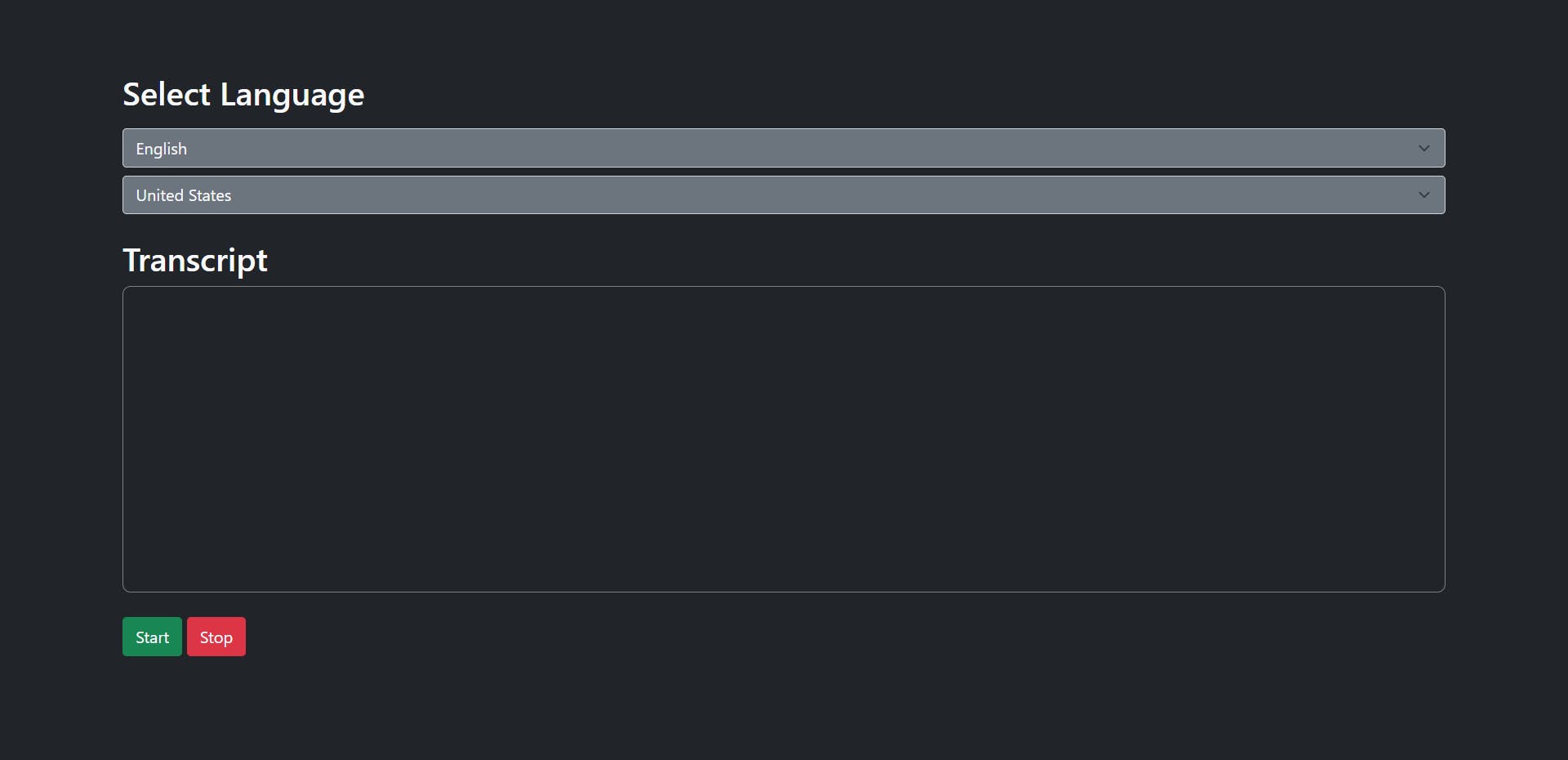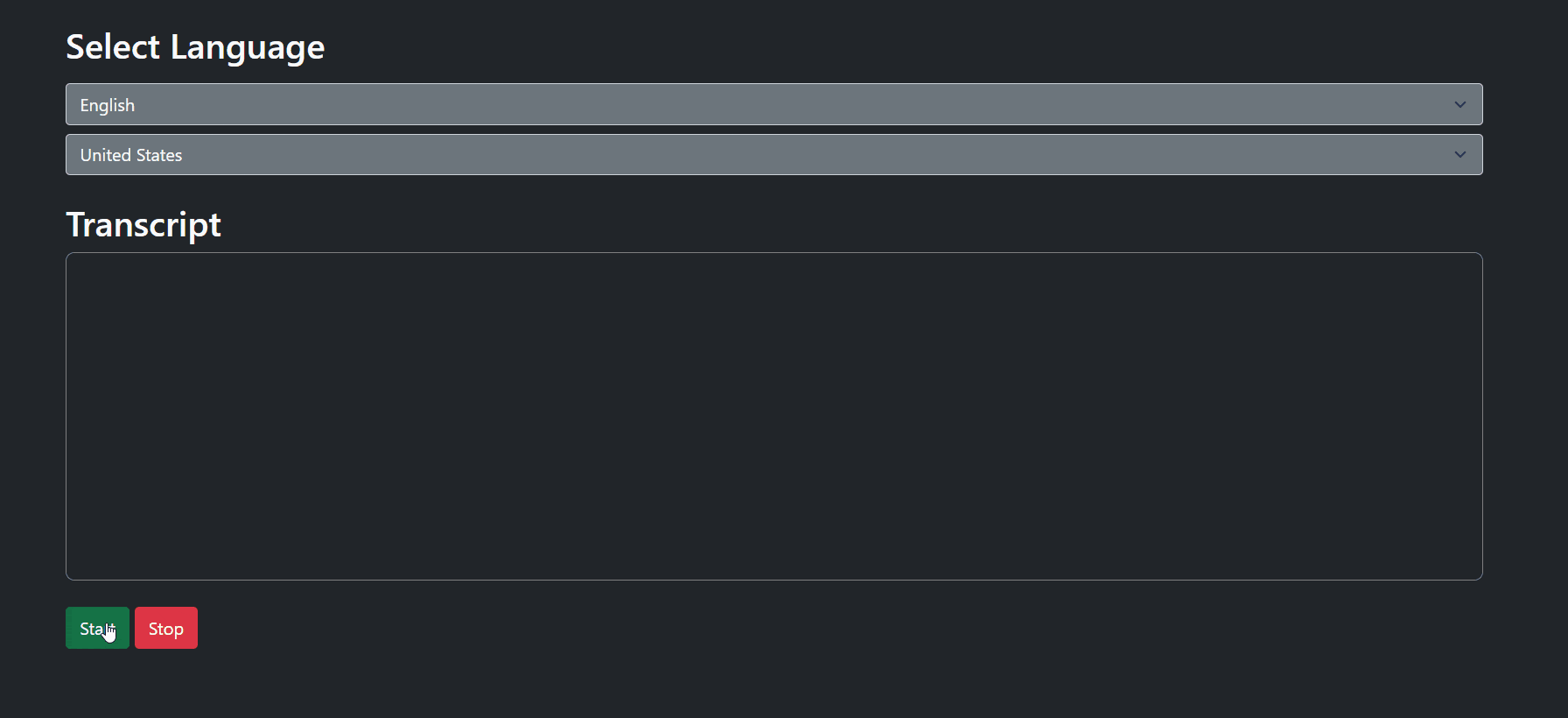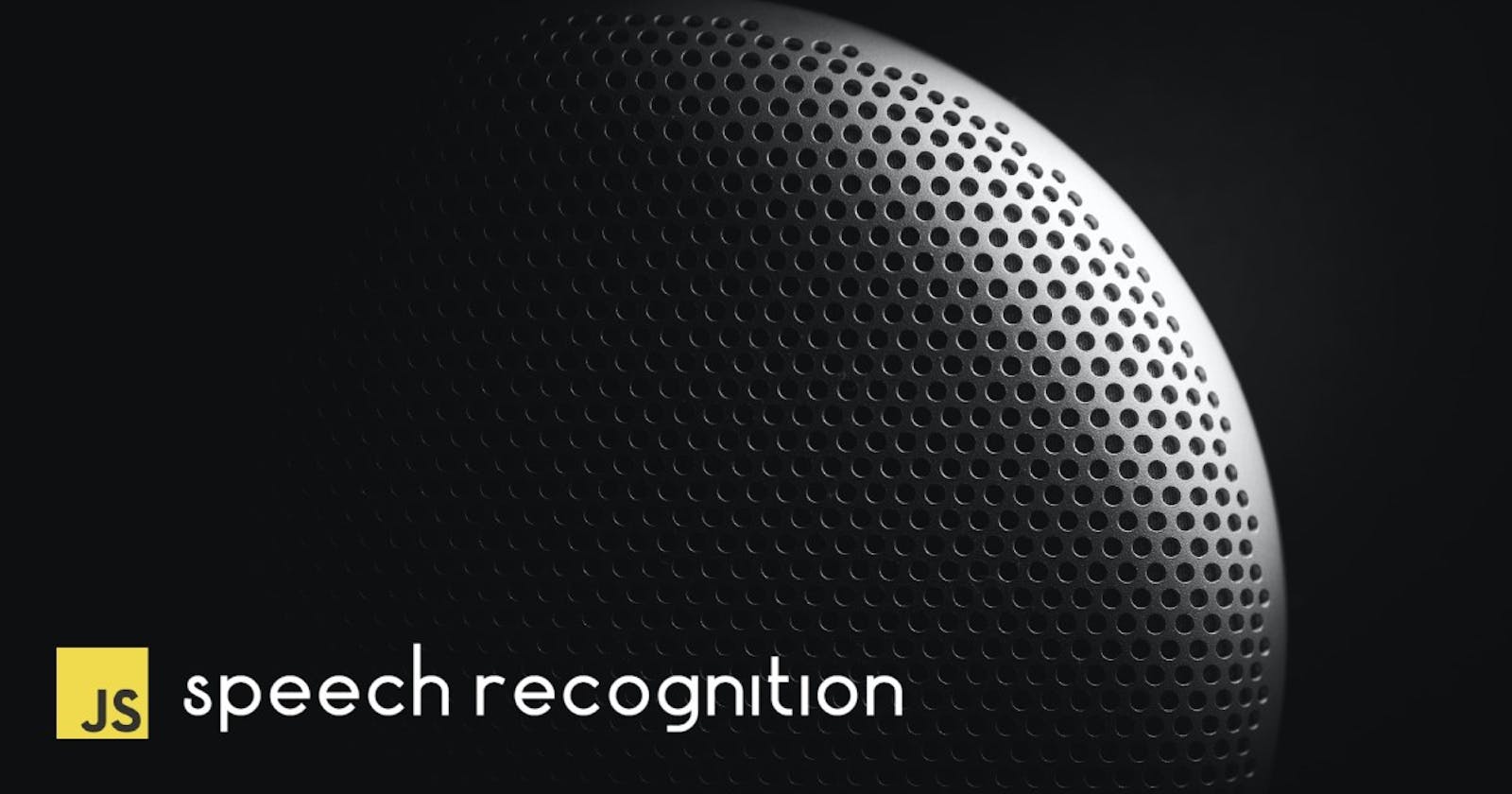The Web Speech API is used to incorporate voice data into web apps. In this tutorial, we will build a simple webpage that uses the Web Speech API to implement speech recognition. You can check the browser compatibility for the Web Speech API here.
Prerequisites
To follow along with this tutorial, you should have:
A basic understanding of HTML and JavaScript.
A code editor. I'll be using Visual Studio Code.
A browser to view the webpage, preferably Google Chrome or Firefox.
Cloning the starter code
To focus more on speech recognition, I've prepared some starter code. You can clone it from this repository on GitHub. Follow the Repository's README for instructions.
For the final code, you can look at this GitHub Repository.
In the starter code, I've set up a language and dialect select menu, two buttons to start/stop the speech recognition, and a box to display the transcript. I've used Bootstrap to style the webpage.

Let's code
First, create a new JavaScript file and name it speechRecognition.js. Next, add the script to the HTML file using the script tag after the body tag.
Adding the
scripttag after thebodytag will make sure that the script file is loaded after all the elements have been loaded to the DOM which aids performance.
<script src="./speechRecognition.js"></script>
Now, inside the script file, let's check if the webkitSpeechRecognition class is available in the window object. If not, let's console.log so that it's not available.
if ("webkitSpeechRecognition" in window) {
// Speech Recognition Stuff goes here
} else {
console.log("Speech Recognition Not Available")
}
Initialization
Everything we write from now on goes inside the if condition.
Let's create a webkitSpeechRecognition object.
let speechRecognition = new webkitSpeechRecognition();
Properties
Now, let's configure some properties on this speechRecognition object.
Continuous listening
The speech recognition object can either stop listening after the user stops speaking or it can keep listening until the user stops it. If you only want to recognize a phrase or a word, you can set this to false. For this tutorial, let's set it to true.
speechRecognition.continuous = true;
Interim results
Interim results are results that are not yet final. If you enable this property, the speechRecognition object will also return the interim results along with the final results. Let's set it to true.
speechRecognition.interimResults = true;
Language
This is the language that the user will speak in. You need to use locale codes to set this property. Please note that not all languages are available in this feature yet.
Let's set the language that the user has chosen from the select menu. You need to select the Dialect select menu and use its value for the language property.
speechRecognition.lang = document.querySelector("#select_dialect").value;
Events & callbacks
You can provide callbacks for events like onStart, onEnd, onResult, and onError.
onStart
This event is triggered when speech recognition is started by the user. Let's pass a callback function that will display that the speech recognition instance is listening on the webpage.
In the starter code, there is a <p> element with an ID called status that says Listening.... It's been hidden by setting the display property of the element to none using CSS.
Let's set it to display: block when the speech recognition starts.
speechRecognition.onstart = () => {
document.querySelector("#status").style.display = "block";
};
onEnd
This event is triggered when the speech recognition is ended by the user. Let's pass a callback function that will hide the status <p> element in the webpage.
Let's set it to display: none when the speech recognition starts.
speechRecognition.onend = () => {
document.querySelector("#status").style.display = "none";
};
onError
This event is triggered when there is some sort of error in speech recognition. Let's pass a callback function that will hide the status <p> element in the webpage.
Let's set it to display: none when the speech recognition starts.
speechRecognition.onError = () => {
document.querySelector("#status").style.display = "none";
};
onResult
This event is triggered when the speechRecognition object has some results from the recognition. It will contain the final results and interim results. Let's pass a callback function that will set the results to the respective <span> inside the transcript box.
This is the HTML code for the transcript box on the web page. The interim results span is colored in a different color to differentiate between the interim results and the final results.
<div class="p-3" style="border: 1px solid gray; height: 300px; border-radius: 8px;">
<span id="final" class="text-light"></span>
<span id="interim" class="text-secondary"></span>
</div>
We need to set the interim results to the span with the ID interim and the final results to the span with the ID final.
The result event will pass an event object to the callback function. This object will contain the results in the form of an array. Each element in the array will have a property called isFinal denoting whether that item is an interim result or a final result.
Let's declare a variable for the final transcript outside the callback function and a variable for the interim transcript inside the callback function.
let final_transcript = "";
speechRecognition.onresult = (event) => {
// Create the interim transcript string locally because we don't want it to persist like final transcript
let interim_transcript = "";
};
Now let's build a string from the results array. We should run it through a loop and add the result item to the final transcript if the result item is final. If not, we should add it to the interim results string.
// Loop through the results from the speech recognition object.
for (let i = event.resultIndex; i < event.results.length; ++i) {
// If the result item is Final, add it to Final Transcript, Else add it to Interim transcript
if (event.results[i].isFinal) {
final_transcript += event.results[i][0].transcript;
} else {
interim_transcript += event.results[i][0].transcript;
}
}
Finally, let's update the DOM with the transcript values.
document.querySelector("#final").innerHTML = final_transcript;
document.querySelector("#interim").innerHTML = interim_transcript;
This is the complete code snippet for the onResult event.
let final_transcript = "";
speechRecognition.onresult = (event) => {
// Create the interim transcript string locally because we don't want it to persist like final transcript
let interim_transcript = "";
// Loop through the results from the speech recognition object.
for (let i = event.resultIndex; i < event.results.length; ++i) {
// If the result item is Final, add it to Final Transcript, Else add it to Interim transcript
if (event.results[i].isFinal) {
final_transcript += event.results[i][0].transcript;
} else {
interim_transcript += event.results[i][0].transcript;
}
}
// Set the Final franscript and Interim transcript.
document.querySelector("#final").innerHTML = final_transcript;
document.querySelector("#interim").innerHTML = interim_transcript;
};
Start/Stop recognition
Finally, let's start and stop the recognition.
We need to set the onClick property of the start and stop buttons to start and stop the speech recognition.
document.querySelector("#start").onclick = () => {
speechRecognition.start();
};
document.querySelector("#stop").onclick = () => {
speechRecognition.stop();
};
Here is the final code for speechRecognition.js:
if ("webkitSpeechRecognition" in window) {
// Initialize webkitSpeechRecognition
let speechRecognition = new webkitSpeechRecognition();
// String for the Final Transcript
let final_transcript = "";
// Set the properties for the Speech Recognition object
speechRecognition.continuous = true;
speechRecognition.interimResults = true;
speechRecognition.lang = document.querySelector("#select_dialect").value;
// Callback Function for the onStart Event
speechRecognition.onstart = () => {
// Show the Status Element
document.querySelector("#status").style.display = "block";
};
speechRecognition.onerror = () => {
// Hide the Status Element
document.querySelector("#status").style.display = "none";
};
speechRecognition.onend = () => {
// Hide the Status Element
document.querySelector("#status").style.display = "none";
};
speechRecognition.onresult = (event) => {
// Create the interim transcript string locally because we don't want it to persist like final transcript
let interim_transcript = "";
// Loop through the results from the speech recognition object.
for (let i = event.resultIndex; i < event.results.length; ++i) {
// If the result item is Final, add it to Final Transcript, Else add it to Interim transcript
if (event.results[i].isFinal) {
final_transcript += event.results[i][0].transcript;
} else {
interim_transcript += event.results[i][0].transcript;
}
}
// Set the Final transcript and Interim transcript.
document.querySelector("#final").innerHTML = final_transcript;
document.querySelector("#interim").innerHTML = interim_transcript;
};
// Set the onClick property of the start button
document.querySelector("#start").onclick = () => {
// Start the Speech Recognition
speechRecognition.start();
};
// Set the onClick property of the stop button
document.querySelector("#stop").onclick = () => {
// Stop the Speech Recognition
speechRecognition.stop();
};
} else {
console.log("Speech Recognition Not Available");
}
Result
You can take a look at the deployed version of the project here.

Let's Recap
We cloned the starter code from the GitHub repository.
We created a new JavaScript file and linked it to the HTML file.
We checked whether the
webkitSpeechRecognitionclass was available on thewindowobject.We created a new instance of the
webkitSpeechRecognitionclass.We set some properties like
continuous,interimResults, andlanguageon that speech recognition instance.We added callback methods for different events like
onStart,onEnd,onError, andonResult.We set the onClick property of the start and stop buttons to start and stop the speech recognition.
Congratulations, :partying_face: You did it.
Happy Coding!
I do all my writing in my spare time, so if you feel inclined, a tip is always incredibly appreciated.

